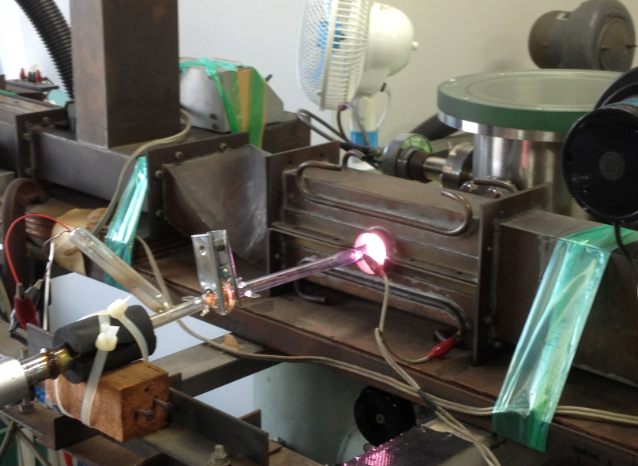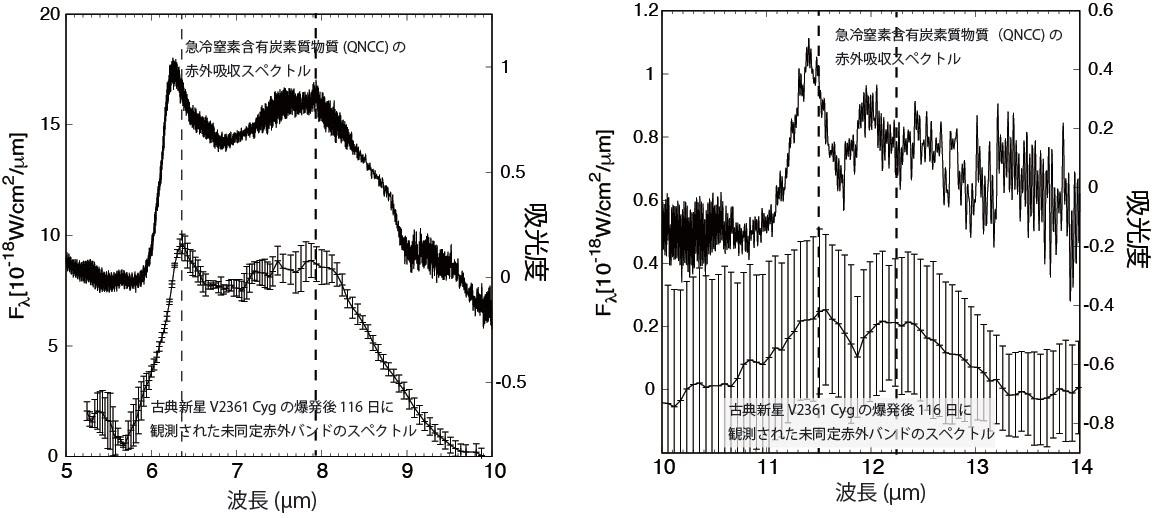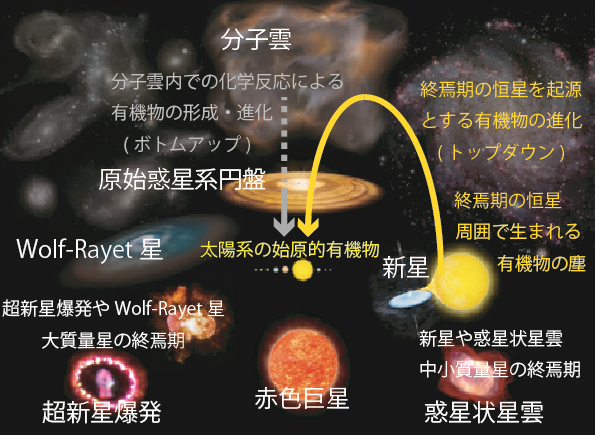DATE2021.08.26 #Press Releases
Successful synthesis of organic dust produced in nova explosions
Disclaimer: machine translated by DeepL which may contain errors.
Izumi Endo (Department of Astronomy, 2nd Year, Doctoral Course)
Tatsuki Sakon, Assistant Professor, Department of Astronomy
Takashi Onaka (Full Professor, Meisei University / Emeritus Professor, Department of Astronomy)
Yuki Kimura, Associate Professor, Institute of Low Temperature Science, Hokkaido University
Points of Presentations
- We have succeeded for the first time in synthesizing organic dust that reproduces the infrared spectrum (Note 2 ) observed in the nova (Note 1).
- We have shown that organic dust containing nitrogen in the form of amine (Note 3), which is important from the viewpoint of a precursor of life, is produced in nova explosions.
- This research has led to an understanding of the appearance of organic dust produced in novas, which are a type of terminal phase of stellar evolution. In the future, we believe that further pursuit of the relationship with primordial organic matter in the solar system will help us to understand the origin of organic matter in the solar system.
Summary of presentation
Understanding how and where organic matter originated in the universe and how it is related to our familiar organic matter is an important research topic in astronomy and astrobiology. Advances in infrared astronomical techniques (Note 4) have suggested the ubiquitous presence of organic molecules and dust such as polycyclic aromatic hydrocarbons (Note 5) in the interstellar medium, but the identification of interstellar organic matter and understanding of their formation processes remain insufficient.
Led by Izumi Endo, a second-year doctoral student at the Graduate School of Science, the University of Tokyo, and Assistant Professor J. Sakon of the Graduate School of Science, the University of Tokyo, Meisei University, Hokkaido University, the University of Electro-Communications, the Japan Aerospace Exploration Agency (JAXA), Yokohama National University, the Japan Agency for Marine-Earth Science and Technology (JAMSTEC), the University of Hyogo, Nihon University, and others, a research group led by A research group from the University of British Columbia and other universities conducted a laboratory synthesis experiment of organic dust by qualitatively simulating the process of organic dust production by a nova, and found that the infrared spectral features observed in the nova were similar to those of amine-containing organic dust, quenched nitrogen-including carbonaceous material ( The results show that the infrared spectral features observed in novas are reproduced by quenched nitrogen-included carbonaceous composite (QNCC ), which is an organic dust containing amines.
The results of this study highlight the birth process of interstellar organic matter in understanding its life in the universe. Organic matter in the universe is key to understanding our origins. Whether they originate on Earth or from space-flight is an important question in contemporary astrobiology research. This study provides an important first step in the search for a possible origin of the latter through the identification of organic dust produced by novas.
Announcement
Since the detection of the unidentified infrared band (Note 6) in the infrared spectrum of planetary nebulae in 1973, it has been widely observed in the infrared spectra of various astronomical environments and interstellar material with the progress of infrared observation techniques (see Figure 1).

Figure 1: Infrared spectrum of interstellar dust in the Milky Way Galaxy obtained by the Infrared Astronomical Satellite AKARI. The characteristic band structure, mainly at 6.2µm, 7.7µm, 8.6µm, and 11.2µm, is called the "unidentified infrared band".
From the main wavelength positions of the unidentified IR bands, it is known that the bearer of these bands is organic matter containing aromatic carbon-carbon and aromatic carbon-hydrogen bonds. Quenched Carbonaceous Composite (QCC) synthesized by Akira Sakata et al. at the University of Electro-Communications in Japan in laboratory synthesis experiments (Note 7) and proposed by A. Leger and J. L. Puget in France and L. Alamandola at NASA Ames in the United States. Interpretation by polycyclic aromatic hydrocarbons (PAHs) has been attempted. However, since it is impossible to actually obtain interstellar organic matter, it is necessary to search for candidates among terrestrial materials and materials synthesized in laboratory experiments and identify them by comparing their infrared spectroscopic properties, relying on information from infrared spectra obtained through astronomical observations. For this reason, the study of organic matter in the universe is difficult, and even now, about 50 years after its discovery, the identity of the interstellar organic matter responsible for the unidentified infrared band has not been identified.
Stars evolve in the universe and eject interstellar material, mainly as stellar winds at the end of their lives, to provide material for the next generation of stars. Interstellar organic matter, which is the bearer of the unidentified infrared band, is thought to be created when stellar winds containing elements synthesized in the interior of a star are scattered into interstellar space. Novas are one of the final stages of such stellar evolution, and are valuable objects that provide us with information on the appearance of interstellar organic matter in the early stages of its formation.
The formation of cosmic dust occurs under high temperature and low pressure, and is difficult to reproduce in the laboratory. In this study, we modified the method proposed by Akira Sakata of the University of Electro-Communications for the synthesis of rapidly cooled carbonaceous matter and used microwave heating to rapidly cool and condense plasma gas generated from nitrogen gas and hydrocarbon solids to qualitatively reproduce the process of organic dust formation from the ejected gas from nitrogen-rich novae (see Figure 2). See Figure 2). We found that the resulting organic dust reproduces the characteristics of the unidentified infrared bands observed around the nova extremely well (see Figure 3). We named the resulting material Quenched Nitrogen-included Carbonaceous Composite (QNCC).


Figure 2: (upper) Synthesis of quenched nitrogen-included carbonaceous composites using a 2.45-GHz microwave-powered plasma generator constructed by Dr. Akira Sakata and his colleagues at the University of Electro-Communications around 1980. (bottom) Synthesis of nitrogen-containing carbonaceous matter (Bottom) Schematic diagram of the synthesis method of the quenched nitrogen-containing carbonaceous material QNCC.

Figure 3: Comparison of the IR absorbance spectrum of the quenched nitrogen-bearing carbonaceous material QNCC with the unidentified IR bands observed in the nova V2361Cyg. The "8 µm band" characteristic of the unidentified IR band of the nova is reproduced extremely well.
The analysis shows that the quenched nitrogen-bearing carbonaceous material contains ~3-5% N/C in the elemental abundance ratio, and that the "amine content" is the key to reproducing the "8 µm band" (see the left side of Figure 3) that characterizes the unidentified IR band of the nova. Although natural materials of terrestrial origin such as coal and heavy oil have been known to reproduce the 8 µm band, their formation process has not been related to the synthesis process of dust around the star. The synthesis process of the quenched nitrogen-bearing carbonaceous material QNCC in this study qualitatively simulates the formation process of organic dust in novae (see Figure 4). In particular, since nitrogen is abundant in the gas ejected from the nova, we experimentally clarified the appearance of organic dust containing nitrogen, which originated from the nova and is important from the viewpoint of a precursor of life.

Figure 4: Illustration of a nova explosion producing organic dust. The white, black, and blue spheres in the molecular model represent hydrogen, carbon, and nitrogen, respectively.
Understanding how and where organic matter is produced in the universe and how it relates to our familiar organic matter is an important research theme in astronomy, especially in astrobiology.
In this study, we perform a laboratory synthesis experiment of organic dust that qualitatively simulates the process of nova production of organic dust, and show that the infrared spectral features observed in novae are reproduced by the quenched nitrogen-containing carbonaceous material QNCC, which is organic dust containing amines.
This result highlights the birth process of interstellar organic matter in our understanding of its life in the universe. Further work is then needed to conclude whether it can be related to primordial organic matter in the solar system, especially after long journeys of time and distance. So far, the origin of organic matter in the solar system has been understood by a pathway that leads to the synthesis of advanced organic matter through chemical reactions during the birth of stars in molecular clouds. On the other hand, another pathway is the possibility that organic dust produced by stars survives long periods of harsh interstellar space and is incorporated into the birth sites of new solar systems. If we can find similarities between QNCC and organic matter extracted from meteorite materials or primordial solar system organic matter obtained by sample return missions, we will be able to answer the question of whether organic dust produced by another star in the past could be the origin of complex organic matter in a primordial solar system. If we can find analogues of organic matter produced by another star in the past, we can answer the question of whether organic dust produced by another star in the past could be the origin of complex organic matter in the primordial solar system (see Figure 5).

Figure 5: A depiction of the life of interstellar organic matter and the origin of primordial organic matter in the solar system. The origin of primordial organic matter in the solar system has conventionally been considered to be the formation process of organic matter through chemical reactions during the formation of the protoplanetary disk, which is the source of the solar system, from molecular clouds, but the process of producing large organic matter has not been fully explained. On the other hand, if there is a way for organic dust produced around a dying star to travel through interstellar space and survive to become the primordial organic material of the solar system, it may be possible to explain the birth process of large organic matter. The present study is an experimental study to reproduce the process of organic dust production by the end-stage stars, which is the first step in considering the latter process.
Journal
-
Journal name The Astrophysical Journal Title of paper On the Nature of Organic Dust in Novae Author(s) Izumi Endo, Itsuki Sakon*, Takashi Onaka, Yuki Kimura, Seiji Kimura, Setsuko Wada, L. Andrew Helton, Ryan M. Lau, Yoko Kebukawa, Yasuji Muramatsu, Sun Kwok Nanako O. Ogawa, Naohiko Ohkouchi, Masato Nakamura, Sun Kwok DOI Number 10.3847/1538-4357/ac0cf1
URL
Terminological Explanation
Note 1 Nova
A binary system consisting of a white dwarf and a companion star, which is mainly a main-sequence star. The mass inflow from the companion star to the white dwarf results in a nuclear fusion reaction on the surface of the white dwarf, causing a surface explosion of hydrogen that has accumulated. During this explosion, gases containing carbon, oxygen, and nitrogen, as well as hydrogen and helium, are ejected into interstellar space. ↑up
Note 2 Infrared Spectrum
In astronomy, infrared radiation refers to the near-infrared (wavelengths from about 1 µm to 3 µm), mid-infrared (wavelengths from 3 µm to 40 µm), and far-infrared (wavelengths from 40 µm to 400 µm). The spectrum shows the energy intensity at each wavelength (see Figure 1). ↑up
Note 3 Amine
A generic term for compounds in which a hydrogen atom of ammonia is replaced by a hydrocarbon group or an aromatic atomic group. In this case, it mainly refers to aliphatic amines, aromatic amines, and heterocyclic amines. ↑up
Note 4: Infrared astronomical observation technology
Of the infrared radiation coming from celestial objects, only a limited amount can be observed from the ground due to atmospheric absorption. Following the small infrared space telescope Infrared Telescope in Space (IRTS) launched in Japan in 1995, the 68.5 cm infrared astronomical satellite AKARI started operations in 2006, followed by the European infrared space observatory ISO, launched in 1995, and the U.S. infrared astronomical satellite Spitzer Space Telescope, launched in 2003. Together with the European infrared space observatory ISO, launched in 1995, and the U.S. Spitzer Space Telescope, which began operations in 2003, AKARI has made important contributions to our understanding of the interstellar medium and interstellar dust. ↑up
Note 5 Polycyclic aromatic hydrocarbons
A generic term for hydrocarbons composed of carbon and hydrogen and fused with aromatic rings. Often called PAH for Polycyclic Aromatic Hydrocarbon, the English name for polycyclic aromatic hydrocarbons. Many of these substances are familiar to many people, such as naphthalene, an insect repellant, and the material used in organic light-emitting diode (OLED) displays. It has been proposed by A. Leger and J. L. Puget of France and L. Alamandola of NASA Ames, USA, as a candidate for a carrier of unidentified infrared band radiation, and their studies have continued. ↑up
Note 6: Unidentified infrared bands
An infrared band structure discovered in 1973 in the infrared spectra of planetary nebulae, with characteristic band emission mainly at 3.3µm, 6.2µm, 7.7µm, 8.6µm, and 11.3µm. It is commonly observed in the infrared spectra of circumstellar environments of stars at various evolutionary stages and in the interstellar material of the Milky Way and extragalactic galaxies, and its bearer is widely recognized as interstellar organic matter, but its exact material identification has not yet been achieved. The unidentified infrared bands observed in the infrared emission of the interstellar medium of galaxies are explained by a radiation process in which organic molecules such as polycyclic aromatic hydrocarbons absorb a single UV photon and release its energy in the form of many infrared photons corresponding to carbon-carbon or carbon-hydrogen vibrational modes. On the other hand, the unidentified infrared bands observed in the circumstellar environment near novas, for example, can be explained by thermal radiation from nanoparticle-sized organic dust heated to several hundred degrees above their equilibrium temperature. ↑up
Note 7 Quenched carbonaceous matter
Material obtained by quenching and condensing plasma made from methane gas using a 2.45 GHz microwave-powered plasma generator by Akira Sakata et al. at the University of Electro-Communications, as a laboratory-synthesized material that was extremely important in the 1980s for explaining the characteristics of unidentified infrared bands and interstellar manuscript curves in the ultraviolet, Together with polycyclic aromatic hydrocarbons, it contributed to our understanding of interstellar organic matter. The same experimental apparatus was transferred from the University of Electro-Communications to The University of Tokyo in 2007. The same experimental apparatus was also used in this study, and nitrogen was successfully incorporated into the produced material, leading to the synthesis of a quenched nitrogen-containing carbonaceous material (see Figure 2). ↑up


